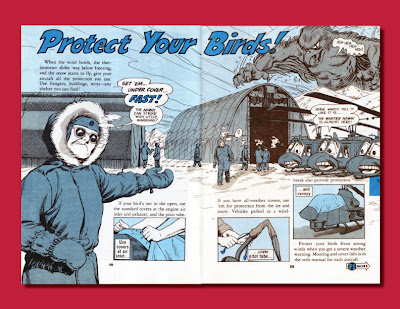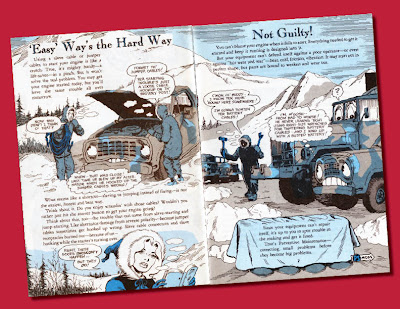We’ve uploaded fifteen graphic selections for this sixteenth BlogPost in our ongoing, year-long salute during this Sixtieth Anniversary Year of the U.S. Army’s internationally acclaimed preventive maintenance publication, PS Magazine. This presentation also is the final segment of a four-part series, Warriors and Weather, lifting up the singular adroitness developed by PS in its recognition and depiction of the challenges, conflicts, worries, and woes that inevitably occur when military tasks and operations are further confounded by the intrusion of season and climate.
Art and design by Murphy Anderson, Will Eisner, and Joe Kubert have been selected not only to exhibit true “weather” eyes and pens, but also to illustrate a discussion of some of the (then) innovative concepts and techniques, recognized and encouraged by the PS staff, and pursued, adapted, and expanded by the contract artists. The publication’s success derives from a delicate melding of mission objectives, technical accuracy, graphic possibilities, and artistic imaginations


One of the earlier issues fully dedicated to weather concerns, during the first decade of PS, was PS 120 which came off the presses in November of 1962, out of Will Eisner’s shop. Its focus was cold weather, and its mission was summarized in the main front-of-the-book spread, Inside Front Cover-Page 1, shown above.
You saw the PS 120 Front Cover, right, in full-size in our preceding BlogPost 15.
The planning for PS 120 began a year in advance. In mid-winter 1961-62, as Managing Editor, I found myself in Alaska and tasked with obtaining both climate and equipment photography for artists’ references, researching situational jargon, and developing a content wish-list from knowledgeable troops—on all rungs of the command-ladder. In the process, I also became aware of the ambiance in a tent at -45°.
Two more cold weather Front Covers by Will are shown below: PS 202 (September 1969) and PS 211 (June 1970), right.


Cold weather depictions by Joe Kubert, the current PS creative art and pre-press services contractor, as previously presented in this series, have displayed his utilization of the PS tradition of pushing the graphic envelope, plus an imaginative enhancement building on it. Joe marked his tenth anniversary with PS this past February.
Joe’s page design above is the Inside Front Cover from PS 627 (February 2005). The one below is Page 2 from PS 696 (November 2010).


Murphy Anderson is a seasoned veteran of PS artistic endeavors at many levels, stretching across two decades, from a hired-pen in Eisner’s shop, through the time of “The Eisner Alumni Group,” and his own nearly ten years as The Man. It has been said—purely in jest, I’m sure—that the only three people in the world who could distinguish between inking by Will Eisner, Mike Ploog, and Murphy Anderson were—Eisner, Ploog, and Anderson.
In our immediately preceding BlogPost 15, we introduced you to Murphy’s PS 323 (October 1979) as another example of a complete issue devoted to cold weather concerns. In that posting, we showed you the Front Cover and Continuity.
Our selection of Murphy’s art for this specific presentation consists solely of two-color, interior, pages from the same issue. The purpose is to display the presence of evolved graphic threads of two-color design, creative use of Ben-Day (benday, if you prefer) screen values, melding of text and art, utilization of every square-centimeter of “real estate,” and a pronounced aversion to templates. This discussion will be continued below.
From PS 323, they are: Pages 4-5, above; and, below, in this order, Pages 58-59, 60-61, 54-55, 10-11, and 6-7. BTW: The “yellow” on Pages 60-61 was not there when they came off the press, but probably were given this “authenticating enhancement” by some ranking NCO with a highlighter.
Considering the known lead-time involved in the four-color elements of PS, it is interesting to note the locale (Glob Island) involved in this sequence. Will probably started the roughs for it not too long after he and I returned from a PS research trip to Asia and the Pacific Basin.
In those days, PS managers were encouraging Eisner to bend and break graphic design barriers regarding PS as effectively as he had those in the world of comics. Unfortunately, technology and economics were the jokers in the deck.
“Typographic ingenuity” was an oxymoron when the Linotype operator was king, “hot” type was the only game in town, and choice of fonts was something of a “vanilla, chocolate, or strawberry” proposition. Ninety-degree angles ruled. Anything other than miles and miles of rigid, straight columns was a stab in the wallet. Irregular measures and wraparounds were fantasies.
Color was something else, again. There was no arguing with the limitations codified by the formulaic charts of the “bogus” four-color separation system based on three fixed values each for C, M, and Y, and you had best stick to plain "solid" for K.
For spot color, which was the purely manual world of the PS two-color interior pages, it all came down to acetate overlays and hand-painted areas. Which meant multiple film shots, agonizing stripping, and multiple burns to plates. It was no wonder that Eisner approached apoplexy when we introduced the idea of duotone mixes of Ben-Day values
He came to like it.
I discussed several aspects of this evolution in my Will Eisner and PS Magazine.
—p.e.f.
Having worked in the medium of comic book reproduction, color and otherwise, no one can appreciate the sweat and vicissitudes Will Eisner, et al, experienced more than I.
Before the advent of the computer, if the components of green (yellow and blue) met less than a quarter of an inch apart, the color print was considered a success. Art corrections were done with razors, scissors and rubber cement. Balloons and sound effects were done by hand with pen, brush and ink. On top of all that, deadlines had to be met.
Gone are the rubber cement and the cut-out corrections. But Will cut a clear path that we can all follow!
—j.k.
UPCOMING BLOG POSTS—
¶ Early Covers Put Eisner, PS in Hot Water
¶ The Best of Zeke Zekely in PS
¶ A Covey of Connie Covers
¶ Perspective Instructional Communications' Best in PS
¶ PS Art Contractors—60 Years of Dedication












































